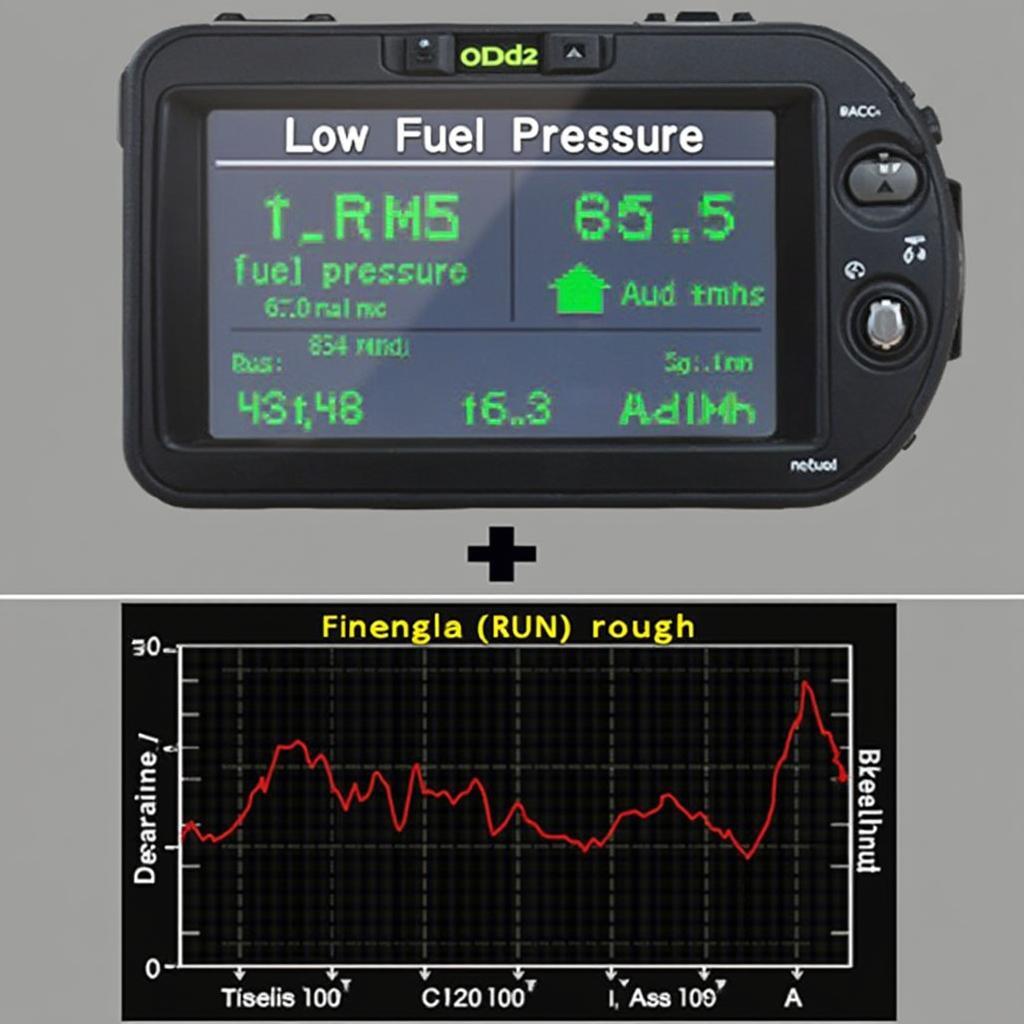The OBD2 fuel pressure PID (Parameter ID) is a crucial diagnostic tool for understanding your vehicle’s fuel system performance. It provides real-time data about the pressure within the fuel system, helping pinpoint potential issues that could affect engine performance and fuel efficiency. This article dives deep into the OBD2 fuel pressure PID, exploring its importance, how to access it, and how to interpret the readings. After reading this, you’ll have a comprehensive understanding of this essential diagnostic parameter.
Understanding fuel pressure is critical for diagnosing various fuel-related issues. A faulty fuel pump, clogged fuel filter, or leaking fuel injector can all manifest as abnormal fuel pressure readings. The OBD2 fuel pressure PID allows you to monitor these fluctuations, helping you identify the root cause of performance problems. For instance, a low fuel pressure reading could indicate a weak fuel pump, while a high reading might suggest a clogged fuel return line. Accessing this data empowers you to troubleshoot effectively and make informed repair decisions. Check out our article on obd2 calculated misfire for information on another important diagnostic parameter.
Accessing the OBD2 Fuel Pressure PID
Accessing the fuel pressure PID depends on the make and model of your vehicle. Not all vehicles support this specific PID. You’ll need an OBD2 scanner, either a dedicated handheld device or a software application paired with a Bluetooth or Wi-Fi adapter. Once connected, navigate to the PID list and look for “Fuel Pressure” or a similar designation. Some scanners might require you to input the specific PID code for your vehicle. Consult your vehicle’s service manual or online resources to find the correct code if needed. You might find our article on obd2 scan tool software toyota useful if you own a Toyota vehicle.
Interpreting OBD2 Fuel Pressure Readings
Typical fuel pressure readings vary depending on the vehicle’s make, model, and engine. Refer to your vehicle’s service manual for the specified normal operating range. Generally, readings between 30 and 80 psi are common. However, these values can fluctuate based on engine load and operating conditions. A significant deviation from the normal range warrants further investigation. For example, consistently low pressure could indicate a failing fuel pump, while unusually high pressure might point to a problem with the fuel pressure regulator.
 OBD2 Scanner Displaying Low Fuel Pressure
OBD2 Scanner Displaying Low Fuel Pressure
Common Causes of Abnormal Fuel Pressure Readings
Several factors can contribute to abnormal fuel pressure readings. These include:
- Failing Fuel Pump: A weak fuel pump struggles to deliver adequate fuel pressure.
- Clogged Fuel Filter: A restricted fuel filter impedes fuel flow, leading to low pressure.
- Faulty Fuel Pressure Regulator: A malfunctioning regulator can cause either excessively high or low pressure.
- Leaking Fuel Injectors: Leaky injectors can disrupt the fuel pressure balance.
- Vacuum Leaks: Leaks in the intake manifold can affect fuel pressure regulation.
“Accurate fuel pressure readings are essential for effective diagnostics. Always refer to your vehicle’s service manual for specific guidelines and troubleshooting procedures,” advises John Miller, a certified automotive technician with over 20 years of experience.
Using OBD2 Fuel Pressure PID for Diagnostics
The OBD2 fuel pressure PID is a valuable tool for diagnosing fuel-related problems. By monitoring the readings under various driving conditions, you can identify intermittent issues that might be difficult to detect otherwise. Logging the data over time can reveal trends and patterns, helping pinpoint the underlying cause of the problem. Understanding how to use this PID effectively can save you time and money on repairs. You can find information on calculating fuel economy using OBD2 data in our article about obd2 mpg.
What is the normal range for OBD2 fuel pressure PID?
The normal range varies depending on the vehicle, but it typically falls between 30 and 80 psi.
Why is my OBD2 fuel pressure PID reading low?
Low readings can be caused by a failing fuel pump, clogged fuel filter, or other fuel system issues.
Can I use any OBD2 scanner to read fuel pressure?
Not all scanners support the fuel pressure PID. Ensure your scanner is compatible with your vehicle.
“Investing in a quality OBD2 scanner that can read fuel pressure is a smart move for any car owner. It’s like having a personal mechanic in your pocket,” adds Sarah Johnson, an automotive engineer specializing in vehicle diagnostics.
Conclusion
The OBD2 fuel pressure PID is a powerful diagnostic tool for understanding your vehicle’s fuel system. By monitoring and interpreting the fuel pressure readings, you can identify potential issues, troubleshoot effectively, and make informed repair decisions. Remember to consult your vehicle’s service manual for specific fuel pressure specifications and troubleshooting procedures. Understanding this key parameter is essential for maintaining optimal vehicle performance and fuel efficiency. Learn more about using OBD2 plugins in our article on obd2 plugin.
FAQs:
- What does PID stand for in OBD2? PID stands for Parameter ID.
- Is fuel pressure a standard OBD2 PID? No, not all vehicles support this PID.
- How can I find the correct fuel pressure PID for my car? Consult your vehicle’s service manual or online resources.
- What should I do if my fuel pressure is too high or too low? Consult a qualified mechanic for diagnosis and repair.
- Can I fix fuel pressure problems myself? Some issues, like replacing a fuel filter, can be DIY projects. However, more complex problems require professional assistance.
- Can a bad fuel pressure regulator affect gas mileage? Yes, a faulty regulator can lead to poor fuel economy.
- How often should I check my fuel pressure? Regular checks during routine maintenance are recommended.
For more insights on fuel-saving devices, check out our article about the effuel eco obd2 fuel saver.
Need assistance? Contact us via WhatsApp: +1(641)206-8880, Email: [email protected] or visit us at 789 Elm Street, San Francisco, CA 94102, USA. Our customer support team is available 24/7.